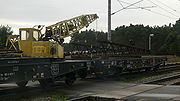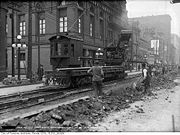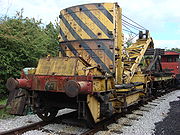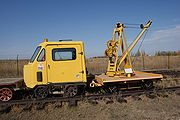
Crane (railroad)
Encyclopedia


A railroad crane, is a type of crane
Crane (machine)
A crane is a type of machine, generally equipped with a hoist, wire ropes or chains, and sheaves, that can be used both to lift and lower materials and to move them horizontally. It uses one or more simple machines to create mechanical advantage and thus move loads beyond the normal capability of...
used on a railroad
Rail transport
Rail transport is a means of conveyance of passengers and goods by way of wheeled vehicles running on rail tracks. In contrast to road transport, where vehicles merely run on a prepared surface, rail vehicles are also directionally guided by the tracks they run on...
for one of three primary uses: freight handling in goods yards, permanent way (PW) maintenance, and accident recovery work. Although the design differs according to the type of work, the basic configuration is similar in all cases: a rotating crane body is mounted on a sturdy chassis fitted with flanged wheels. The body supports the jib (UK) (boom (US)) and provides all the lifting and operating mechanisms; on larger cranes, an operator's cabin is usually provided. The chassis is fitted with buffing and coupling gear to allow the crane to be moved by a locomotive, although many are also self-propelled to allow limited movement about a work site.
For cranes with a jib that extends beyond the length of the chassis, a match wagon (also known as a 'jib carrier' (UK) or 'boom car' (US)) is provided to protect the jib and to allow the crane to be coupled within a train. The match wagon is usually a long, flat wagon that provides a means of securing the jib for transportation; storage areas for special equipment or supplies are usually fitted too. It was not uncommon for the match wagon to be built on a withdrawn revenue-earning wagon.
Goods yard cranes
Usually the smallest of the railroad cranes, goods yard cranes were used in the larger goods yards to provide lifting capability in areas away from the ground-mounted goods cranes normally provided in such yards.They were often small enough to be operated by hand, and were not normally self-propelled, instead requiring the use of a shunting engine to move them into position. Once cheap road-going mobile cranes were available, these superseded the rail-mounted variety due to their greater flexibility and mobility.
Maintenance cranes
The most varied forms of crane are used for maintenance work. General purpose cranes may be used for installing signalling equipment or pointwork, for example, while more specialised types are used for track laying.Breakdown cranes
The largest cranes are used for accident recovery work, usually forming part of a breakdown train that includes staff accommodation and recovery equipment. These are large enough to lift derailed rolling stock back onto the track, although two or more cranes may be required to safely recover a locomotive. In US terminology, a 'breakdown crane' is often referred to as a 'wrecker'.Construction
A railroad crane generally resembles a conventional fixed-location crane except that the platform the crane sits on is a heavy-duty reinforced flat car. Directly underneath the center of gravityCenter of gravity
In physics, a center of gravity of a material body is a point that may be used for a summary description of gravitational interactions. In a uniform gravitational field, the center of mass serves as the center of gravity...
for the crane is a pivot point that allows the crane to swivel around 360°; in this way the crane can locate its boom over the worksite no matter what its location is along the track. The trucks
Bogie
A bogie is a wheeled wagon or trolley. In mechanics terms, a bogie is a chassis or framework carrying wheels, attached to a vehicle. It can be fixed in place, as on a cargo truck, mounted on a swivel, as on a railway carriage/car or locomotive, or sprung as in the suspension of a caterpillar...
on the car under the crane will often include traction motor
Traction motor
Traction motor refers to an electric motor providing the primary rotational torque of a machine, usually for conversion into linear motion ....
s so that the crane is able to move itself along the track, and possibly tow additional cars.
Larger cranes may be provided with outrigger
Outrigger
An outrigger is a part of a boat's rigging which is rigid and extends beyond the side or gunwale of a boat.In an outrigger canoe and in sailboats such as the proa, an outrigger is a thin, long, solid, hull used to stabilise an inherently unstable main hull. The outrigger is positioned rigidly and...
s to provide additional stability when lifting. Sleepers
Railroad tie
A railroad tie/railway tie , or railway sleeper is a rectangular item used to support the rails in railroad tracks...
are often carried on the match car to put under the outriggers to spread the weight applied to the trackbed.
Breakdown cranes (sometimes called wrecking cranes or 'big hooks') were necessary to every railroad to recover derailed rolling stock and engines; while also assisting with bridge building and yard construction.
History
In the early days of the railways, locomotives and rolling stock were small enough to be re-railed manually using jacks and tackle, but as they became bigger and heavier this method became inadequate.Enter into this the steam crane and cable winch. Appearing about 1890, the cranes increased in size, commensurate with the rise of steel Pullman cars, so by 1910 cranes reached their peak of development. Many of these 1910-era cranes were so useful and powerful, that they remained in service until the 1980s. The combination of a quick-firing steam boiler, heavy steam winch, and cable hook could little be improved upon, and thus remained in service. Also, steam engines did not mind being parked for months, with a little care, and were ready to go to work when needed.
In the 1980s big, hydraulic controlled diesel cranes appeared. Also, these cranes had the ability to travel on the highway so as to better able to get to the scene of an accident. They are much more mobile, and are able to manoeuvre around an accident scene, better than a crane only limited to rail access.
In the 1990s a new generation of railway cranes was developed. While the conventional diesel hydraulic road cranes were adopted with some small trolleys to move on the rail track, the new generation had a professional high speed railway chassis for up to 75 mph. The superstructure is also diesel hydraulic with telescopic boom and counterweight and designed to the railway's specific needs. These cranes can travel with suspended loads and keep levelled even on an elevated track, due to the automatic cant compensation. It is possible to work on one outrigger only, work with boom in horizontal position under bridges or under the overhead wires. Capacities are as high as 200 m/t (metric). It makes this new generation useful for maintenance work and switch and crossing renewal, as well as recovery work.
Great Britain

- Cowans, Sheldon & Company, Carlisle – cranes are labelled Cowans Sheldon
- Ransomes & Rapier
- Thomas Smith & Sons (Rodley) Ltd – cranes are labelled Smith Rodley (not "Smith & Rodley")
- Taylor & Hubbard LtdTaylor & Hubbard LtdTaylor & Hubbard was an engineering company founded in Leicester, specialising in the production of railway cranes. They later moved to Kent Street, Humberstone Road, Leicester, in approximately 1900 which gave them access to the railway siding ....
, LeicesterLeicesterLeicester is a city and unitary authority in the East Midlands of England, and the county town of Leicestershire. The city lies on the River Soar and at the edge of the National Forest...
USA
- American Hoist and Derrick
- Arva IndustriesArva IndustriesArva Industries is a company that specializes in work equipment for military, industrial, rail and resource sectors. The company is based in St. Thomas, Ontario.-Products:* RT56 Vacuum rodder car* AVRA0309 Hydraulic crane* AVRA0280 Hydraulic crane...
- Badger Equipment Company http://www.badgerequipment.com
- BucyrusBucyrus InternationalBucyrus International, Inc. , was an American surface and underground mining equipment company. Founded as Bucyrus Foundry and Manufacturing Company in Bucyrus, Ohio, in 1880, Bucyrus moved company headquarters to South Milwaukee, Wisconsin in 1893. In its early history, Bucyrus produced steam...
- Industrial Brownhoist
- Link-Belt
- LimaLima Locomotive WorksLima Locomotive Works was an American firm that manufactured railroad locomotives from the 1870s through the 1950s. The company took the most distinctive part of its name from its main shops location in Lima, Ohio. The shops were located between the Baltimore & Ohio's Cincinnati-Toledo main line...
- Little Giant Corporation http://www.littlegiantcorp.com
- MarionMarion Power ShovelMarion Power Shovel Company designed, manufactured and sold steam shovels, excavators and dragline excavators for use in the construction and mining industries....
- Ohio Railroad Crane
- Swingmaster Corporation http://www.swingmastercorp.com
Preservation

Heritage railway
thumb|right|the Historical [[Khyber train safari|Khyber Railway]] goes through the [[Khyber Pass]], [[Pakistan]]A heritage railway , preserved railway , tourist railway , or tourist railroad is a railway that is run as a tourist attraction, in some cases by volunteers, and...
s in the UK have one or more preserved railway cranes, either just as historic exhibits, or as fully functioning examples assisting with the operation of the railway. Although not normally required for re-railing activities, they are exceptionally useful for track relaying and the restoration of locomotives and rolling stock, and help to avoid expenditure on outside contractors.
Three cranes of various sizes are preserved at the Western Pacific Railroad Museum
Western Pacific Railroad Museum
The Western Pacific Railroad Museum in Portola, California, formerly known as the Portola Railroad Museum before , is a heritage railroad that preserves and operates historic American railroad equipment. The museum's mission is to preserve the history of the Western Pacific Railroad and is...
at Portola, California
Portola, California
Portola is the only incorporated city in Plumas County, California, United States. The population was 2,104 at the 2010 census, down from 2,227 at the 2000 census...
. They are all cranes once owned by the Western Pacific Railroad
Western Pacific Railroad
The Western Pacific Railroad was a Class I railroad in the United States. It was formed in 1903 as an attempt to break the near-monopoly the Southern Pacific Railroad had on rail service into northern California...
and two of them, a small, self-propelled Burro Crane and a large, 200-ton capacity Industrial Brownhoist crane, are maintained in operable condition.
All Japanese railway cranes had already retired. Road cranes are used for re-railing and maintenance works. Type "so-30" railway crane for accident recovery is preserved at Otaru synthesis museum. Type "so-80" railway crane for accident recovery is preserved at Sakuma railpark. Type "so-300" railway crane for bridge construction is preserved at Usuitouge tetsudo bunkamura.

